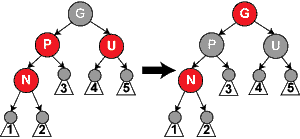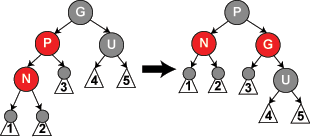由于AVL树不适用一些经常修改的结构,这是因为AVL树追求绝对的平衡,所以就有了一种近似平衡的二叉搜索树红黑树,相对而言,降低了插入和旋转的次数,所以在经常进行增删的结构中性能比AVL树更优,而且红黑树实现比较简单,所以实际运用中红黑树更多。
红黑树在每个结点上增加一个存储位表示结点的颜色,可以是Red或Black,它有这些特点:
- 每个结点不是红色就是黑色
- 根节点是黑色的
- 如果一个节点是红色的,则它的两个孩子结点是黑色的
- 对于每个结点,从该结点到其所有后代叶结点的简单路径上,均包含相同数目的黑色结点
- 每个叶子结点都是黑色的(此处的叶子结点指的是空结点)
由于红黑树的这些特点,所以红黑树能保证其最长路径中节点个数不会超过最短路径节点个数的两倍
红黑树的插入:
首先按照二叉搜索树的规则插入新节点,如果新节点设为黑色,就会导致根到叶子的路径上有一条路上,多一个额外的黑节点,这个是很难调整的。但是设为红色节点后,可能会导致出现两个连续红色节点的冲突,那么可以通过颜色调换和树旋转来调整
插入红色节点后,分情况讨论当前红黑树的状态
- 其双亲节点的颜色是黑色,没有违反红黑树任何性质,则不需要调整
- 其双亲节点的颜色是红色,约定n为当前节点,p为父节点,g为祖父节点,u为叔叔节点
(2.1) n为红,p为红,g为黑,u存在且为红,则需要将p、u改为黑,g改为红,然后把g当成n,继续向上调整

(2.2) n为红,p为红,g为黑,u不存在/u为黑
(2.2.1) p为g的左孩子,n为p的左孩子,进行右单旋转,同理p为g的右孩子,n为p的右孩子,进行左单旋转

(2.2.2) p为g的左孩子,n为p的右孩子,进行左旋转后变为情况2.2.1,再进行右旋
同理p为g的右孩子,n为p的左孩子,进行右旋转后变为情况2.2.1,再进行左旋

1
2
3
4
5
6
7
8
9
10
11
12
13
14
15
16
17
18
19
20
21
22
23
24
25
26
27
28
29
30
31
32
33
34
35
36
37
38
39
40
41
42
43
44
45
46
47
48
49
50
51
52
53
54
55
56
57
58
59
60
61
62
63
64
65
66
67
68
69
70
71
72
73
74
75
76
77
78
79
80
81
82
83
84
85
86
87
88
89
90
91
92
93
94
95
96
97
98
99
100
101
102
103
104
105
106
107
108
109
110
111
112
113
114
115
116
117
118
119
120
121
122
123
124
125
126
127
128
129
130
131
132
133
134
135
136
137
138
139
140
141
142
143
144
145
146
147
148
149
150
151
152
153
154
155
156
157
158
159
160
161
162
163
164
165
166
167
168
169
170
171
172
173
174
175
176
177
178
179
180
181
182
183
184
185
186
187
188
189
190
191
192
193
194
195
196
197
198
199
200
201
202
203
204
205
206
207
208
209
210
211
212
213
214
215
216
217
218
219
220
221
222
223
224
225
226
227
228
229
230
231
232
233
234
235
236
237
238
239
240
241
242
243
244
245
246
247
248
249
250
251
252
253
254
255
256
257
258
259
260
261
262
263
264
265
266
267
268
269
270
271
272
273
274
275
276
277
278
279
280
281
282
283
284
285
286
287
288
289
290
291
292
293
294
295
296
297
298
299
300
301
302
303
304
305
306
307
308
309
310
311
312
313
314
315
316
317
318
319
320
321
322
323
324
325
326
327
328
329
330
331
332
333
334
335
336
337
338
339
340
341
342
343
344
345
346
347
348
349
350
351
352
353
354
355
356
357
358
359
360
361
362
363
364
365
366
367
368
369
|
#include <iostream>
enum COLOR {
RED, BLACK
};
template <class V>
struct RBTNode {
RBTNode(const V& data = V())
: _data(data)
, _left(nullptr)
, _right(nullptr)
, _parent(nullptr)
, _color(RED) {}
V _data;
RBTNode<V>* _left;
RBTNode<V>* _right;
RBTNode<V>* _parent;
COLOR _color;
};
template <class V>
class _RBTreeIterator {
public:
typedef RBTNode<V> Node;
typedef Node* pNode;
typedef _RBTreeIterator<V> Self;
_RBTreeIterator(pNode node)
: _node(node) {}
V& operator*() {
return _node->_data;
}
V* operator->() {
return &_node->_data;
}
bool operator!=(const Self& it) {
return _node != it._node;
}
bool operator==(const Self& it) {
return _node == it._node;
}
Self& operator++() {
if (_node->_right) {
_node = _node->_right;
while (_node->_left) {
_node = _node->_left;
}
} else {
pNode parent = _node->_parent;
while (parent->_right == _node) {
_node = parent;
parent = parent->_parent;
}
if (_node->_right != parent) {
_node = parent;
}
}
return *this;
}
Self& operator--() {
if (_node->_parent->_parent == _node && _node->_color == RED) {
_node = _node->_right;
} else if (_node->_left) {
_node = _node->_left;
while (_node->_right) {
_node = _node->_right;
}
} else {
pNode parent = _node->_parent;
while (parent->_left == _node) {
_node = parent;
parent = parent->_parent;
}
_node = parent;
}
}
private:
pNode _node;
};
template <class K, class V, class KeyOfValue>
class RBTree {
public:
typedef RBTNode<V> Node;
typedef Node* pNode;
typedef _RBTreeIterator<V> iterator;
RBTree(const V& data = V()) {
_header = new Node(data);
_header->_left = _header;
_header->_right = _header;
_header->_parent = nullptr;
}
iterator begin() {
return iterator(_header->_left);
}
iterator end() {
return iterator(_header);
}
iterator Find(const V& data) {
KeyOfValue kov;
if (_header == nullptr) {
return nullptr;
}
pNode cur = _header->_parent;
while (cur) {
if (kov(cur->_data) > kov(data)) {
cur = cur->_left;
} else if (kov(cur->_data) < kov(data)) {
cur = cur->_right;
} else {
return iterator(cur);
}
}
return iterator(nullptr);
}
std::pair<iterator, bool> Insert(const V& data) {
if (_header->_parent == nullptr) {
pNode root = new Node(data);
root->_color = BLACK;
root->_parent = _header;
_header->_left = root;
_header->_right = root;
_header->_parent = root;
return std::make_pair(iterator(root), true);
}
pNode cur = _header->_parent;
pNode parent = nullptr;
KeyOfValue kov;
while (cur) {
parent = cur;
if (kov(cur->_data) > kov(data)) {
cur = cur->_left;
} else if (kov(cur->_data) < kov(data)) {
cur = cur->_right;
} else {
return std::make_pair(iterator(cur), false);
}
}
cur = new Node(data);
pNode newNode = cur;
if (kov(parent->_data) > kov(data)) {
parent->_left = cur;
} else {
parent->_right = cur;
}
cur->_parent = parent;
while (cur != _header->_parent && cur->_parent->_color == RED) {
pNode parent = cur->_parent;
pNode gParent = parent->_parent;
if (gParent->_left == parent) {
pNode uncle = gParent->_right;
if (uncle && uncle->_color == RED) {
parent->_color = uncle->_color = BLACK;
gParent->_color = RED;
cur = gParent;
} else {
if (parent->_right == cur) {
RotateLeft(parent);
std::swap(cur, parent);
}
RotateRight(gParent);
parent->_color = BLACK;
gParent->_color = RED;
break;
}
} else {
pNode uncle = gParent->_left;
if (uncle && uncle->_color == RED) {
uncle->_color = parent->_color = BLACK;
gParent->_color = RED;
cur = gParent;
} else {
if (parent->_left == cur) {
RotateRight(parent);
std::swap(cur, parent);
}
RotateLeft(gParent);
parent->_color = BLACK;
gParent->_color = RED;
break;
}
}
}
_header->_parent->_color = BLACK;
_header->_left = leftMost();
_header->_right = rightMost();
return std::make_pair(iterator(newNode), true);
}
pNode leftMost() {
pNode cur = _header->_parent;
while (cur && cur->_left) {
cur = cur->_left;
}
return cur;
}
pNode rightMost() {
pNode cur = _header->_parent;
while (cur && cur->_right) {
cur = cur->_right;
}
return cur;
}
void RotateRight(pNode parent) {
pNode subL = parent->_left;
pNode subLR = subL->_right;
subL->_right = parent;
parent->_left = subLR;
pNode gParent = parent->_parent;
parent->_parent = subL;
if (subLR) {
subLR->_parent = parent;
}
if (parent != _header->_parent) {
if (gParent->_left == parent) {
gParent->_left = subL;
} else {
gParent->_right = subL;
}
subL->_parent = gParent;
} else {
_header->_parent = subL;
subL->_parent = _header;
}
}
void RotateLeft(pNode parent) {
pNode subR = parent->_right;
pNode subRL = subR->_left;
subR->_left = parent;
parent->_right = subRL;
if (subRL) {
subRL->_parent = parent;
}
if (parent != _header->_parent) {
if (parent->_parent->_left == parent) {
parent->_parent->_left = subR;
} else {
parent->_parent->_right = subR;
}
subR->_parent = parent->_parent;
} else {
_header->_parent = subR;
subR->_parent = _header;
}
parent->_parent = subR;
}
void _Inorder(pNode root) {
if (root) {
_Inorder(root->_left);
std::cout << root->_data.first << ":" << root->_data.second << " ";
_Inorder(root->_right);
}
}
void Inorder() {
_Inorder(_header->_parent);
std::cout << std::endl;
}
bool isRBTree() {
pNode root = _header->_parent;
if (root == nullptr) {
return true;
}
if (root->_color == RED) {
return false;
}
int blackCount = 0;
pNode cur = root;
while (cur) {
if (cur->_color == BLACK) {
++blackCount;
}
cur = cur->_left;
}
return _isRBTree(root, blackCount, 0);
}
bool _isRBTree(pNode root, int blackCount, int curBlackCount) {
if (root == nullptr) {
if (curBlackCount != blackCount) {
return false;
}
return true;
}
if (root->_color == BLACK) {
++curBlackCount;
}
if (root->_parent->_color == RED && root->_color == RED) {
return false;
}
return _isRBTree(root->_left, blackCount, curBlackCount)
&& _isRBTree(root->_right, blackCount, curBlackCount);
}
private:
pNode _header;
};
|
1
2
3
4
5
6
7
8
9
10
11
12
13
14
15
16
17
18
19
20
21
22
23
24
25
26
27
28
29
30
31
32
33
34
35
36
37
38
39
40
41
42
43
44
45
46
47
48
49
50
51
52
53
54
55
56
57
58
59
60
61
62
63
64
65
66
| #include "RBTree.hpp"
template <class K, class V>
class Map {
struct MapKeyOfValue {
const K& operator() (const std::pair<K, V>& data) {
return data.first;
}
};
public:
typedef typename RBTree<K, std::pair<K, V>, MapKeyOfValue>::iterator iterator;
iterator Find(const K& key) {
return _rbt.Find(std::make_pair(key, V()));
}
iterator begin() {
return _rbt.begin();
}
iterator end() {
return _rbt.end();
}
std::pair<iterator, bool> Insert(const std::pair<K, V>& data) {
return _rbt.Insert(data);
}
V& operator[](const K& key) {
std::pair<iterator, bool> ret = _rbt.Insert(std::make_pair(key, V()));
return ret.first->second;
}
private:
RBTree<K, std::pair<K, V>, MapKeyOfValue> _rbt;
};
template <class K>
class Set {
struct SetKeyOfValue {
const K& operator()(const K& data) {
return data;
}
};
public:
typedef _RBTreeIterator<K> iterator;
iterator Find(const K& key) {
return _rbt.Find(key);
}
iterator begin() {
return _rbt.begin();
}
iterator end() {
return _rbt.end();
}
std::pair<iterator, bool> Insert(const K& data) {
return _rbt.Insert(data);
}
private:
RBTree<K, K, SetKeyOfValue> _rbt;
};
|



